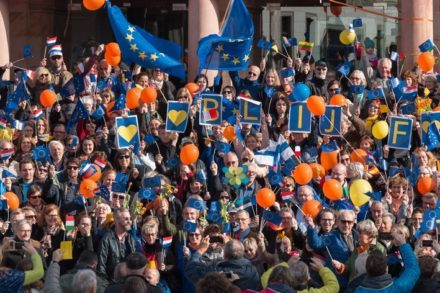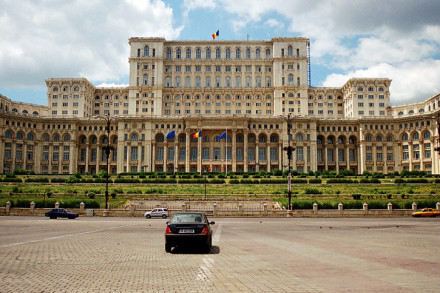In a small German town, Peter walks into a bank branch and takes a photo of the document stating the different interest rates the local Sparkasse is charging for deposits. The bank displays this information publicly and after the call of the journalistic platform Correctiv on facebook, people all over Germany went to different branches and took a photo of these documents and sent them to the editors of Correctiv.
Last November the online platform Correctiv started their research experiment. They called upon the public to support them with their research on the bank Sparkasse. The bank is one of the biggest banks in Germany and has 416 independent banks all acting under the umbrella of the group’s regional and national associations. They employ around 240.000 people and every second person in Germany has an account at one of their branches. Furthermore the bank is funded publicly making the local or regional government to shareholders of the branches.
This special funding model was one reason why Correctiv is aiming at a comparison of the finances of all the individual banks of the group. Together with the well-known German newspaper FAZ, they started their campaign inviting every citizen to participate in their project. People have been asked to compare the conditions of the different branches regarding interest rates, salary of the management board, revenue and dividend pay-out. The FAZ as well as Correctiv argue that such a big number of cases can just be handled with the help of the public.
But why is there even a need for a project like this? According to the editor of the German weekly newspaper Zeit, Giovanni di Lorenzo, traditional journalism has been facing different challenges in recent times. One issue editorial offices have to handle are shrinking funds and therefore, a lack of resources. This threatens the basic task of journalism acting as an independent and neutral institution controlling the government as a fourth power.
Correctiv as a platform tries to step in by looking at issues which are not covered by the traditional media. They are a substitute to journalism supporting the editorial offices with thorough research which also counts for the research on Sparkasse. However, by educating people about their right of information, Correctiv goes one step further. They not only provide people with the right information but also teach them to look and ask for information by themselves. On their website they offer different tutorials about the general right of information and how to interpret and compare financial documents.
Since November 2015, 500 people have joined the project with diverse motivations. Some are interested in the topic itself, some want to learn and practice journalistic skills and others just want to watch and see what happens. But whatever their motivation is, those who are actively participating are controlling the political system and strengthening democracy. At this point one could say that with projects like Correctiv, the problem of decreasing resources within journalism is solved to a certain extent. However, according to Giovanni di Lorenzo, another issue traditional journalism faces, is the increasing number of articles and reports written in a very scandalous way just for the sake of click numbers and attention.
By looking into topics for which traditional media do not have the funds, Correctiv claims to address this problem as well as it helps creating a better form of journalism. This relates to another very recent journalistic project started by three scientists. Perspective Daily is an online magazine which claims to provide their readers with constructive journalism meaning not only to inform about problems but also to discuss possible solutions. The crowdfunded project successfully completed their funding aim of 12 000 subscribers at the end of March and will start publishing an article a day in May, this year.
Following the claims of both journalistic projects, it seems like traditional journalism isn’t fulfilling its job properly. There wouldn’t be a need for either one of the projects if traditional journalism would cover the issues people are really interested in. Perspective Daily and Correctiv fill this gap with an investigative journalism looking at the pressing issues of our society. Stories of Correctiv are indeed quite successful and are published by several big German magazines and newspapers. However, in comparison to 46 million customers of the bank Sparkasse, 500 people who joined the project show that participation is still something for a small number of people. In the case of Perspective Daily one also has to see if the number of 12.000 supporters will increase further and if the crowdfunding model will be able to support the project in the future.
Despite these issues, both projects show that there seems to be a need for a different form of journalism. Because of the complexities of today’s problems people seem to be wanting to read not only what happens but also want to go deeper, read about in-depth explanations and see possible solutions. And in order to achieve this, some are even prepared to invest their own time or money to support this form of journalism.
Is this a better form of journalism? Investigative, constructive and participative journalism seems to be the perfect form of journalism covering the issues people are interested in and really care about. But what about the ideal of journalism being a neutral institution? Can research on just one German bank paint a neutral and balanced picture of the situation within the financial market or is it more like a targeted attack on an anyways criticised brand? Do we really want to be presented with ready-made solutions, so we do not have to make up our own minds?
Besides all the good effects projects like the two presented have on our society, they bear the risk of losing the fundamental claim of journalism to be a neutral institution. The question in future will be, if neutrality stays as important as it has been or if there will be a shift in the definition of what we understand as journalism.
Picture was taken from Flickr, by Maja Dumat.




